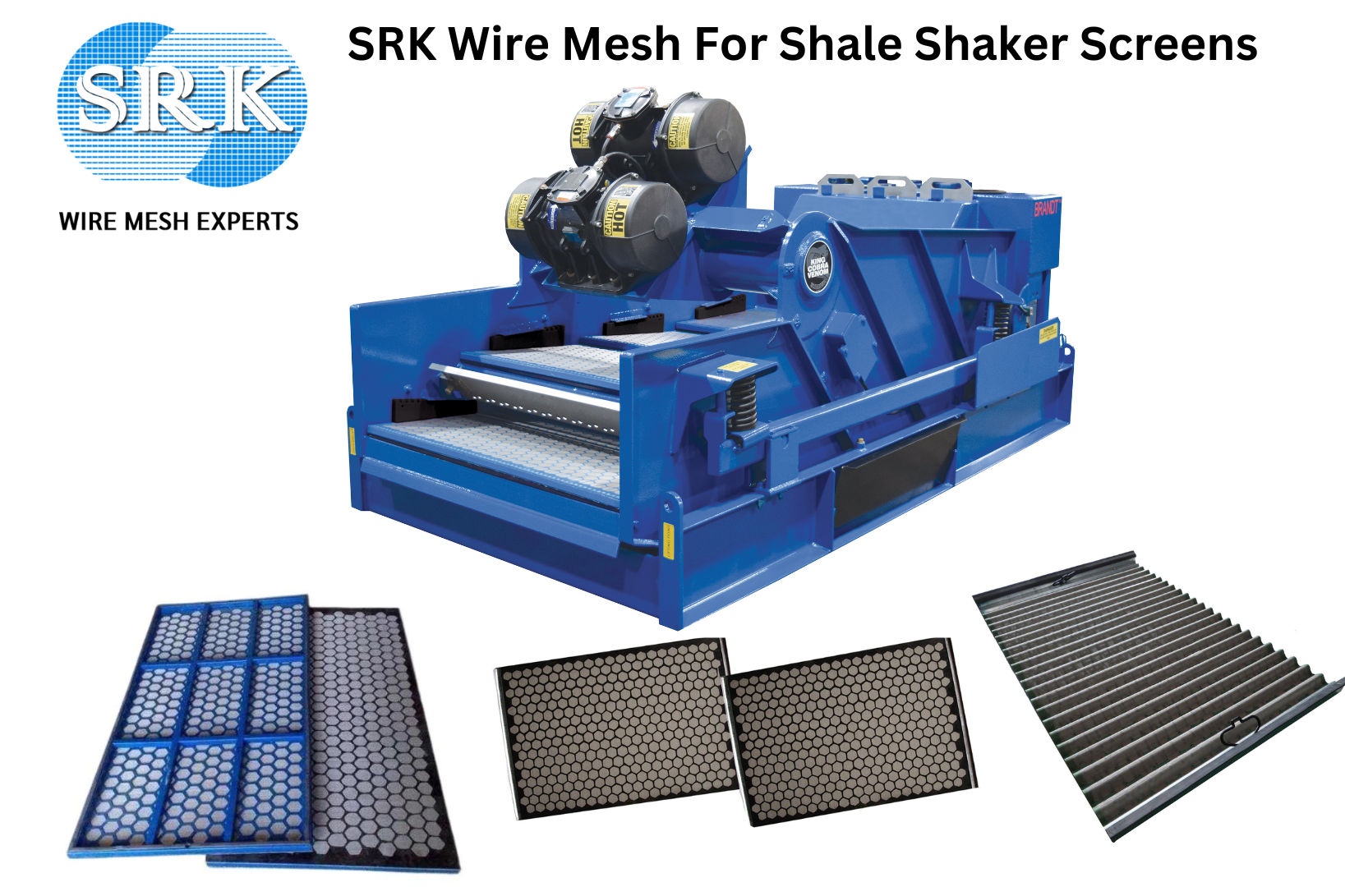In the realm of oil and gas drilling, the wire mesh utilized in shale shakers holds critical importance in the solid control process. These meshes, integral components of shaker assemblies, play a meticulous role in filtering drilling fluids and are also employed for extracting sizable solid cuttings from the drilling fluid known as mud and separate solids from liquids and ensuring the efficiency of drilling operations. However, amidst the myriad choices available, selecting the ideal wire mesh can be an overwhelming task. Fear not! Let’s embark on a comprehensive journey to unravel the complexities involved in choosing the perfect wire mesh for shale shaker screens.
Understanding about the Shale Shaker Screen and its Role
Before delving into the nuances of mesh selection, comprehending the primary role of a shale shaker screen is vital. This pivotal piece of equipment forms the core of the solid control system. Its primary function involves sieving drilling fluids and extracting solid particles while enabling the purified fluid to circulate seamlessly, thereby optimizing the drilling process.
Types of Shale Shaker Screens Wire Mesh
Wire mesh for shale shaker screens comes in varied types, each tailored to specific functionalities. Some prominent types include:
Hook Strip shale shaker screens: Known for their hassle-free installation and removal, these meshes are a preferred choice across diverse drilling operations.
Composite Frame Shale Shaker Screens: These screens combine a steel frame with a composite material. They offer increased longevity, improved resistance to corrosion, and often have higher conductance.
Metal-backed shale shaker screens: Featuring a metal structure like stainless steel wire mesh and other metals, for instance, added support, these screens are durable and provide better resistance against wear and tear, enhancing their lifespan.
Mesh Rating for Shale Shaker Screens
The mesh rating system is crucial in the oil and gas industry, particularly in shale shaker screens used for solids control. The size of the required wire mesh is based on the size of the particles that can pass through a screen. Here’s a table showcasing mesh ratings with micron sizes, API designations, and corresponding API D100 separations. The API is adhering to standards set by the American Petroleum Institute (API). These meshes are categorized based on mesh size and conductance.
This table shows the relationship between mesh ratings, API designations, and the corresponding API D100 separation sizes in microns, which helps in selecting the appropriate screen for effective solids control in shale shakers within the oil and gas drilling process.
|
MESH RATING (BASED ON TOP LAYER MESH) |
API DESIGNATION | API D100 SEPARATION
(MICRONS) |
|
10 Mesh |
API – 10 | > 1,850.0 to 2,180.0 |
| 12 Mesh | API – 14 |
> 1,290.0 to 1,550.0 |
|
16 Mesh |
API – 16 | > 1,090.0 to 1,290.0 |
| 24 Mesh | API – 20 |
> 780.0 to 925.0 |
|
30 Mesh |
API – 25 | > 655.0 to 780.0 |
| 38 Mesh | API – 35 |
> 462.5 to 549.0 |
|
50 Mesh |
API – 50 | > 275.0 to 327.5 |
| 70 to 75 Mesh | API – 60 |
> 231.0 to 275.0 |
|
80 to 90 Mesh |
API – 70 | > 196.0 to 231.0 |
| 100 to 120 Mesh | API – 80 |
> 165.0 to 196.0 |
|
130 to 140 Mesh |
API – 100 | > 137.5 to 164.9 |
| 150 to 175 Mesh | API – 120 |
> 116.5 to 137.5 |
|
180 to 190 Mesh |
API – 140 | > 98.0 to 116.5 |
| 200 to 210 Mesh | API – 170 |
> 82.5 to 98.0 |
|
220 to 250 Mesh |
API – 200 | > 69.0 to 82.5 |
| 270 Mesh to 280 Mesh | API – 230 |
> 58.0 to 69.0 |
| 325 Mesh | API – 325 |
> 41.5 to 49.0 |
Understanding Mesh Sizes and Configurations
Determining the appropriate mesh size is pivotal. Mesh size signifies the number of openings per linear inch and directly influences the mesh’s ability to filter particles. Finer mesh sizes effectively filter smaller particles, while larger mesh sizes enable the passage of larger particles.
The size chart of wire mesh serves as a valuable guide, offering a standardized classification system. It simplifies the selection process based on mesh sizes and conductance, aiding in choosing the right wire mesh.
Factors Influencing the Selection of Wire Mesh
Drilling Fluids and Flow Rate: Varied drilling fluids necessitate specific mesh configurations. Grasping the composition and viscosity of fluids is pivotal in selecting a mesh capable of handling them effectively. Additionally, considering the flow rate aids in determining the mesh’s capacity to process fluids efficiently.
Mesh Longevity and Efficiency: The durability and lifespan of a mesh, often termed its “screen life,” are critical considerations. Opting for a durable mesh ensures cost-effectiveness and minimizes downtime due to frequent replacements. Furthermore, prioritize meshes designed for high efficiency to enhance the solid control process.
Cost of the mesh: While cost is a significant factor, striking a balance between quality and price is essential. Multiple manufacturers offer wire meshes for shale shaker screens at varying price points. Assessing their reputation, product quality, and after-sales support is imperative to making an informed decision.
To Get Answers to Your Most Commonly Asked Questions About Shale Shaker Wire Mesh
What is a Shale Shaker Wire Mesh?
A shale shaker The wire mesh is a pivotal component of the shale shaker that separates solid particles from drilling fluids.
What is the function of a shaker?
The primary function of a shaker is to filter drilling fluids, extracting solid particles to ensure smooth drilling operations.
What size mesh is ideal for a shale shaker screen?
Shale shaker screen wire meshes come in various sizes, ranging from coarse to fine, and are designed to filter different particle sizes.
What SS grades are we generally using for shale shaker screens?
Shale shaker screens vary in design and functionality. Common types include hook strip wire meshes and API RP 13C wire meshes.
What types of features can you avail of in wire mesh for shale shaker screens?
Selecting the right wire mesh for shale shaker screens is a multifaceted process that demands a comprehensive understanding of drilling requirements, mesh types, sizes, and manufacturers. Prioritizing factors such as drilling fluids, flow rates, mesh longevity, and efficiency ensures an optimized solid control system, contributing to a smoother and more efficient drilling process.
In essence, the crux lies not only in choosing a mesh but also in identifying the perfect match for your specific drilling needs a choice that withstands high performance, durability, and cost-effectiveness. Delve into the specifics, explore the array of options, and make an informed decision that paves the way for an efficient drilling operation.
Get Certified Solutions for Your Project’s Needs.
Enhance your drilling operations with precision and efficiency. Explore our premium range of wire mesh for shale shaker screens at SRK Metals. Our comprehensive guide on selecting the ideal mesh ensures optimized solid control systems for your specific drilling needs. Contact us today to discover the perfect match that promises durability, high performance, and cost-effectiveness for a seamless drilling process.

